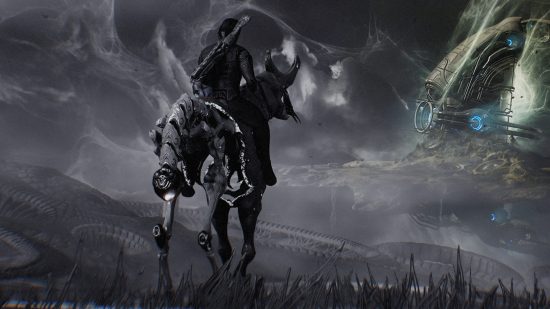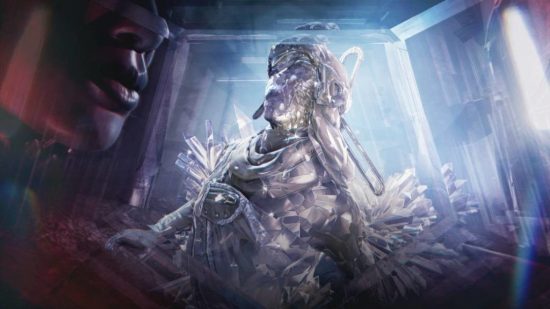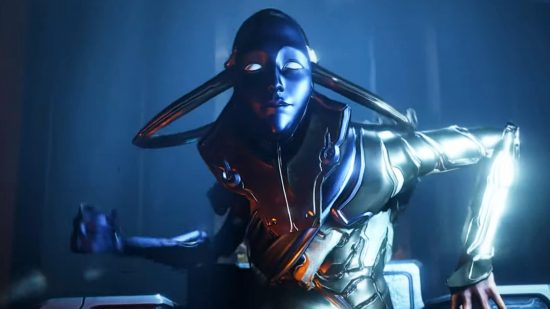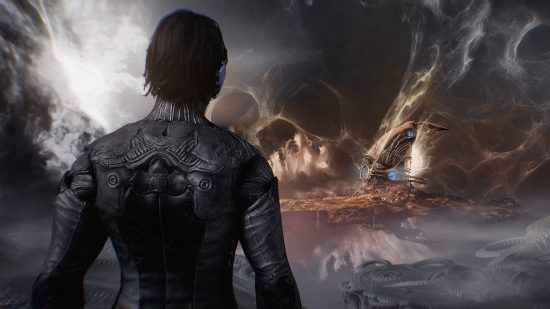Warframe Duviri Paradox gameplay has finally been shown this year at TennoCon after several years since its initial surrealist, paradoxical trailer back in 2019. The main focus is on the newly introduced Drifter, the New War Tenno Operator who wasn’t saved during the Zariman incident. If you have played New War to completion, this will make much more sense, as it tells the story of a new Tenno Operator that has a very different set of experiences.
With New Wars’ use of temporal studies introduced, Warframe’s creative director Rebecca Ford and the development team were able to explore a ‘what-if scenario’ – but is it truly a what-if scenario if it technically did happen in another reality for our Operator main character?
“The 2019 Duviri Paradox trailer showed the ‘adult Tenno’ because we knew we wanted to play with the idea that there is another ‘you’ out there. Where did they come from? That’s what the New War served to establish, but we really wanted – even at that time – a way to tell a story that allowed us to bring that Drifter into the picture; so we could push beyond. Because there’s no world we want people to have to grow their own characters up, and never go back,” Ford said.
Ford goes on to elaborate on the importance of the Child God powers that never got an opportunity to ‘grow up’. “But then [the development team asked,] ‘What-if?’ Then the Drifter entered the picture, and the what-if turned into New War and Duviri Paradox. It has been very fun to watch unfold,” she states, when asked if this was the inaugural plan from the 2019 trailer.
Alignments
Alignments in Warframe have given the players morality choices in more of the main story content in the past few years. These alignments are not focused on solely good or evil decisions like many other games implement; instead, they’re more nuanced.
Due to this being the first playable expansion as solely through the journey of the Drifter I asked whether we would be making similar choices with the alignment system, or if it would be making a comeback this time around.
“Honestly in my mind, I’ve considered that the Tenno Operator’s journey, and the Drifter hasn’t been taught those [same] moralities. The Drifter has their own choices to make to get to a point, where they could even be considered a Tenno at which point they would have learned from the morality system. The choices we have to make in the context of the Duviri Paradox at this point are not alignment ones, but we do have a flavour layer that we are working on,” Ford had explained.
The development team this time around will be trying other mechanics with the Drifter’s story, so it will not be the same as what Warframe players have been accustomed to in prior expansions within the main overarching narrative.
Rogue-Lite, Rogue-Like, and All New Gameplay Mechanics
Duviri Paradox will be set in an open world ruled by King Thrax. Thrax’s main goal is to control this entire environment, which players will see from the outset. A glowing hand comes to save the Drifter from being executed, and you will be tasked to escape.
You’ll have to avoid the guards, and all you have is a glowing hand that shoots bursts of colour. While initially successful, the guards quickly overwhelm the Drifter, and the Drifter is killed.
Well, that’s what it looks like.
Time is then reset, and you start over again. Trying a different approach, the Drifter sneaks away and stealthily dispatches enemies so as not to arouse suspicion.
Learning from your mistakes and trying again is at the forefront of Duviri Paradox’s gameplay systems. These are reminiscent of rogue-lites and rogue-likes, genres that Warframe has not really delved into before. These optional buffs or perks are called Decrees. You will also have choices to increase fire damage or have a horse earlier on.
“The bulk of the stuff we wanted to do with the rogue-lite and rogue-like choices is rooted in our existing mod system, and our Gear loadouts. We have over 400 weapons, 1000 mods, 50 Warframes, and what if all of that was funnelled into a system where players get to engage with all that content, but they get to do it in a very controlled context that resets every day? Everything they have collected and come to love matters now in a different way for Duviri [Paradox] because your Drifter’s going to wake up, it is the start of a new day and the choices they make are going to be heavily dependent on their gear or the way they like to engage with that gear. If you always love critical stuff, you can go down a critical path for that day. So it’s very much more of a reflection of your way you enjoy playing core Warframe,” Ford states.
This time around, there will be more puzzles to solve to add an extra layer to the constant combat players are used to. “That idea of problem solving with ways other than shooting all the time are pretty thematic to Duviri. You saw the puzzle we did in the demo, where you’re controlling two realities at once, and you’ll have to activate realities,” Ford said.
Each day will be reset by the King, so the approach to play will be different, but will remain player-friendly. NPC locations and activities will change daily, maybe tasking you to play a certain way one day, and a completely different way the next. Standing, Syndicates, or a main town hub will not be in this environment.
“Instead of having a centralised location with all NPCs you engage with, we’re splatting them out around the land. So this open-world version of quest giver will be somewhere out in the world,” Ford said. One day there could be a library, another day there could be a giant theatre. “We’re going to let players become experts of each day’s plan.”
A different progression system is in play this time around, and it borrows from other parts of the game that will maintain over a player’s account. “It’s more persistent across the resets because we felt Syndicate Standing would be hard; especially if the citizens maybe don’t remember what you did the day before. How can you gain Standing with people that are reset,” Ford said, but admitted she couldn’t go into much detail. What she does say, though, is that there are some exciting things in the works.
“The world of Duviri will be extremely different for every day cycle we’re giving, so that players can see at a glance the colour story. When the King is happy there will be purple trees, and everything will be glowing. But, when he is p**sed – it’s going to be fire and red. The colour story is a big part of it,” Ford said.
There will be five different ‘moods’ the King will experience, and each mood will have NPCs scattered across different places depending on the King’s current mood.
Though it may sound daunting for players at first, Ford reassured us, “we’re hoping players that anytime they want to engage with [the gameplay], they will be rewarded, but it’s not like you have to do 365 [days] in a row at all.”
Control through colour
The monochromatic universe can be used as an aesthetic metaphor of control through its gameplay. In a previous essay of mine on De Blob’s authoritarianism, I had examined colour being used to control civilians, change innocents, and corrupt the world of De Blob.
Seeing the black and white environment with King Thrax made me recall these exact themes from De Blob. I could hardly contain my excitement that this is where Warframe is heading as the impetus for this large open-world environment.
When talking with Ford, who was one of the main people spearheading the themes of colour (or lack thereof, in this case), the state of control in regards to my previous analysis on De Blob I had described in comparison resonated similarly with Duviri Paradox’s aesthetics also interwoven with gameplay mechanics.
Ford reveals “we always knew we wanted [colour] to be a metaphor for control, and the human experience. When your life is devoid of colour, and someone else is making that decision for you – you feel hopeless. There’s a lot of human experience rattled up in that where, when someone else is calling the shots like that you feel like you can’t bring anything to life to make it worth living. We wanted to play with colour, the fact that the player’s agency is what’s bringing colour into the world to tell that story, and have it reach a peak where colour becomes really important thematically once you’re done the quest.”
Creatures
The gargantuan Void Wyrm was teased back in 2019’s trailer, and I asked Ford about this flying behemoth. “Players will be ending a lot of their days – not all of them – but a lot of them by taking down a Void Wyrm. It is very much meant to be an enemy that you engage with,” Ford explained.
Warframe is known for its different mounts. The Archwing, the K-Drive, and the Voidrig. This time around for Duviri Paradox, we get an all-new type of mount, since this will be in a Void environment as the Drifter. Players will be able to work their way in crafting a Kaithe, a mechanical horse that can fly with huge wings as shown in today’s demo. Wings spread out from a leap of faith.
“It’s not like Archwing flight or anything. They are a flying mount,” Ford said.
The Kaithes will be available in three different versions, but at the moment will only be cosmetic-based unlike the Kubrow, which can be different powerhouses among players. “Right now I think we’re keeping it all cosmetic rather than function because we don’t want to necessarily put something something so highly utility in the rogue-lite decision making. We want to make sure people get to play with what they want rather than what the optimal mount is,” Ford had said.
The team at the moment is not designing a mount-based combat overall. “We want to make sure we are really careful. [Kaithes are] mostly cosmetic,” Ford continued.
What is ‘Duviri’?
One of the last things I wanted to ask was about the word “Duviri”. I explained to Rebecca that in Sanskrit the word “Dvari” meant “gate” or “door”, and if this was an intentional choice for this expansion’s title. Ford had said, “Honestly, this is one of those things [where] we work with a really amazing artist, Keith Thompson. [Keith] sent us original concepts probably four and a half years ago, and he is so smart. It’s very possible he knew [Duviri/Dvari] means ‘door’ in Sanskrit. [The expansion’s theme is] very much that. If it works, it works.”
Players were able to get a slice of the Duviri Paradox through Warframe’s new amphitheatre that teleported Tenno in the game to provide a virtual visitation, while TennoCon 2022 this year is a digital-only event due to the pandemic. “The intention is it’s a very fun teaser for people. They get to actually see [the Duviri Paradox.]”



